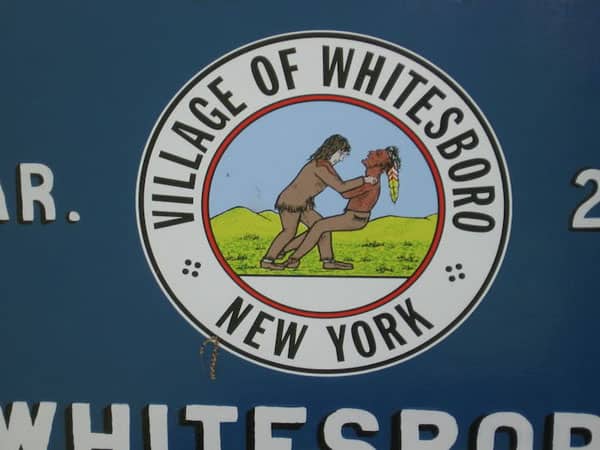Residents in Whitesboro, N.Y., Vote to Keep a Much-Criticized Village Emblem
Marc Santora, New York Times, January 12, 2016
The official emblems of towns and villages generally attract little attention. Often pastoral, they are generally gentle and unassuming. Not so the seal of the Village of Whitesboro, in central New York.
A white man appears to be throttling a Native American man–clearly identified by the feather in his hair–and wrestling him to the ground. The Native American, eyes closed and head cast back, is on the verge of defeat.
{snip}
For the past four decades, with varying degrees of intensity, its appropriateness has been debated, and on Monday, after an online campaign derided the logo as racist, residents voted on its fate.
They decided overwhelmingly to keep it, with 157 of 212 votes in favor of letting the image represent the Oneida County community, which has a population of roughly 3,700.
{snip}
The story behind the seal, as relayed by the village historian, Judy Mallozzi, on the Whitesboro website, goes like this:
In 1784, Hugh White moved to Sedauquate, now Whitesboro, “where he was the first white inhabitant in the state of New York west of the German settlements on the Mohawk.”
The Oneida Indians called the area home, and Mr. White sought to maintain good relations and exercise “much diplomacy” in dealing with his neighbors, according to the history.
One day, an Oneida chief visited Mr. White and, in a spirit of good will, challenged him to wrestle.
“White dared not risk being browbeaten by an Indian nor did he want to be called a coward,” according to the story. “In early manhood, he had been a wrestler, but of late felt he was out of practice.”
Still, he would rather risk defeat than appear afraid.
“He accepted the challenge, took hold of the Indian and by a fortunate trip, succeeded almost instantly in throwing him,” according to the story.
At that moment, the bond between Mr. White and the Oneida chief was sealed. “In all ways, White dealt fairly with the Oneida tribe and gained their confidence,” according to the story.
{snip}
















